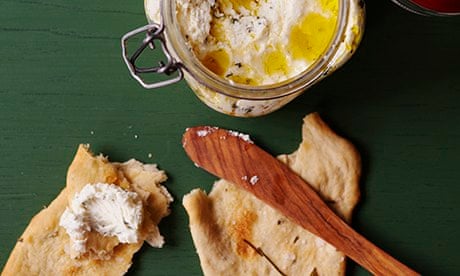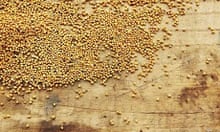Crisp rosemary and olive oil flatbread (pictured)
Nothing could be easier than making this flatbread, but that doesn't mean you shouldn't tell people that you slaved all day over it …
Makes 3
230g plain flour
1 tbsp chopped rosemary, plus 2 sprigs
1 tsp bicarbonate of soda
¾ tsp salt
125ml water
75ml olive oil plus more for brushing
Salt
1 Preheat the oven to 220C/450F/gas mark 7. Stir together the flour, chopped rosemary, bicarbonate of soda and salt in a medium bowl. Make a well in the centre, then add the water and oil and gradually stir into the flour with a wooden spoon until a dough forms. Knead it gently on a work surface 4 or 5 times.
2 Divide the dough into 3 pieces, cover 2 of them with clingfilm and roll out the other on a sheet of baking paper into a 25cm round (the shape should be rustic, the dough thin).
3 Lightly brush the top with additional oil and scatter small clusters of rosemary on top, pressing in slightly. Sprinkle with sea salt. Bake on a preheated oven tray until pale golden and browned in spots – about 8-10 minutes. Transfer the flatbread to a rack to cool, then repeat with the other more rounds.
4 Flatbreads can be made 2 days ahead and cooled completely, then kept in an airtight container at room temperature.
Recipe supplied by Deb Perleman, smittenkitchen.com (Adapted from Gourmet, July 2008)
Shaved brussels sprouts, olive oil, lemon and pecorino
A recipe that is enough to convert even the most ardent sprouts–averse folk.
Serves 4-6
450g brussels sprouts
5 tbsp extra virgin olive oil
½ tsp salt
3½ tbsp fresh lemon juice
½-1 tsp whole black peppercorns, crushed
115g pecorino cheese, grated or shaved
1 Rinse the sprouts, then pat dry with kitchen roll. Remove any discoloured outer leaves, then cut the sprouts in half, lengthways. Very thinly slice them the sprouts crossways, transferring to a large, shallow serving bowl as you go.
2 Drizzle the oil over the sprouts, sprinkle with salt and toss well. Add the lemon juice and pepper and toss again. Lay the cheese on the top of the salad and serve immediately.
The Perfectly Tossed Salad by Mindy Fox (Kyle Books)
Spaghetti with olive oil, chilli and garlic
This is one the most basic sauces in the Italian repertoire, but when done properly, it is a little masterpiece. You can replace the parsley with basil, or use some of each.
Serves 4
400g spaghetti
200ml extra virgin olive oil
3 garlic cloves, finely chopped
1 red chilli, finely chopped
A large handful of flat-leaf parsley, finely chopped
Salt
1 Cook the spaghetti in plenty of boiling salted water until al dente.
2 Meanwhile, heat the oil in a heavy-based frying pan over a low heat, and fry the garlic for 1-2 minutes, stirring with a wooden spoon to spread the flavour through the oil. Add 2 tbsp cooking water to the pan and stir in the chilli and parsley. Season with salt and cook for 3 minutes, mixing occasionally.
3 When the spaghetti is ready, drain it quickly so it is still rather wet and add it to the sauce. Gently toss to coat, then leave for a minute over a low heat before serving on hot plates.
The Art of Pasta by Lucio Galletto and David Dale (Grub Street)
Ribollita (tuscan bean soup)
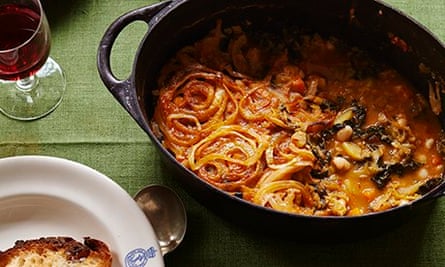
For this Tuscan bean soup, the beans need to soak for 12 hours and the soup prepared a day in advance to allow the flavours to develop before it is reheated, hence its name, "reboiled". The soup really comes alive when topped with good quality olive oil to finish.
Serves 6–8
For cooking the beans
225g dried cannellini beans, soaked for about 12 hours in cold water
1 onion, cut into quarters
1 small celery stalk, cut into pieces
3 garlic cloves, sliced
Sprigs of fresh sage, rosemary and parsley
For the soup
5 tbsp extra virgin olive oil
1 onion, sliced
½–1 tsp crushed dried chillies
Salt and black pepper
2 ripe fresh tomatoes, peeled, deseeded and coarsely chopped
1 tbsp tomato puree
3 potatoes, cut into small cubes
2 carrots, cut into small cubes
1 small leek, white and green parts, cut small
3 celery stalks, cut into small pieces
250g cavolo nero, shredded
200g savoy cabbage, shredded
2 garlic cloves, sliced
3 or 4 sprigs fresh thyme
To serve
1 or 2 mild onions
6–8 slices of country-style bread
2 garlic cloves, cut in half
Extra virgin olive oil
1 Drain and rinse the beans, then put them in a large, heavy pot with all the ingredients for cooking the beans. Pour in enough cold water to cover the beans by about 5cm, and bring slowly to the boil. Cover the pan and cook very gently until they are very tender – about 1½ hours.
2 Using a slotted spoon, lift the beans out of the liquid (leave the herbs and vegetables in the stock). Puree ¾ of the beans coarsely in a food processor, then turn them into a bowl. Leave the remaining beans whole and set aside. Strain the cooking liquid into another bowl, discarding the herbs and vegetables.
3 Put the olive oil into the pot in which the beans were cooked. Add the onion and chillies, sprinkle with a pinch of salt, and fry for about 10 minutes. Add the tomatoes and tomato puree and cook for 2–3 minutes, then mix in the bean puree. Stir for a couple of minutes to let it take up all the flavours, then add all the other vegetables, plus the garlic and thyme.
4 Measure the bean cooking liquid and add enough water to make it up to about 1.5 litres. Add this to the pot with salt, and bring to the boil, then cook over the lowest possible heat for about 2 hours. Add in some pepper and check for seasoning. Remove from the heat and leave overnight.
5 The next day, preheat the oven to 180C/350F/gas mark 4. Mix the whole beans into the soup. Slice the onions very finely and arrange in a thin layer over the surface of the soup. Put the pot in the oven and cook until the onion is tender; this will take about 1 hour.
6 Rub the bread with the halved garlic cloves, then toast under the grill. Put the bread into individual soup bowls and ladle the soup over it. Drizzle good quality extra virgin olive oil over each bowl and serve.
Anna Del Conte's New Gastronomy of Italy (Pavilion)
Patatas a lo pobre (poor man's potatoes)
This Spanish classic is the perfect accompaniment to any meat or fish dish.
Serves 4
1 large onion, thinly sliced
4 medium potatoes, such as maris piper or red king Edward, peeled and cut into 1cm slices
1 large green pepper, deseeded and thinly sliced
2 tbsp sherry vinegar
200ml olive oil
Salt and black pepper
1 Mix the onion, potatoes and pepper, season with the salt, pepper and vinegar.
2 Heat the olive oil in a large frying pan over a medium heat and add the vegetable mixture. Cook for about 20 minutes, turning over occasionally. The vegetables should be soft, but not too crispy.
Tapas Revolution by Omar Allibhoy (Ebury)
Olive oil biscotti
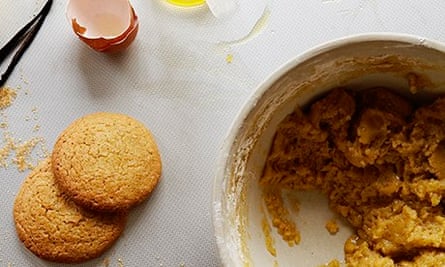
Most typical Italian biscotti are made with butter but this recipe uses olive oil instead, creating a lighter, slightly different flavour.
Makes 50-60
230ml extra virgin olive oil
170g caster sugar
130g demerara sugar
1 vanilla pod
1 lemon zest
2 eggs
1 tbsp milk
330g plain flour, sifted
A pinch of salt
1 tsp bicarbonate of soda
1 Mix together the olive oil, sugars, vanilla and lemon zest. Add the eggs and milk, and mix well, then add the sifted flour, salt and bicarbonate of soda, and let the dough rest for 24 hours.
2 Preheat the oven to 170C/340F/gas mark 3-4. Roll the dough into small balls, flatten slightly then bake in the oven for 8-10 minutes, until golden brown.
Recipe supplied by Francesco Mazzei, L'Anima restaurant
Swiss chard and parma ham tart with olive oil crust
This pastry dough comes together by hand in minutes, calls for pantry ingredients, and rolls out well thanks to its flexible yet cohesive consistency. It then bakes into a lightly crunchy, flavorsome crust.
Makes 1 large tart
250g wholewheat flour
1 tsp salt
1 tsp dried rosemary or thyme
60ml olive oil
120ml cold water
For the filling
1kg Swiss chard
Olive oil
1 onion, thinly sliced
Salt and black pepper
2-3 tbsp pesto
2 tbsp oats
1 egg, beaten
Parma ham, to serve
1 Lightly grease a 28-30cm tart tin. Combine the flour, salt, and herbs in a medium mixing bowl. Add the oil and mix it in with a fork. Add the water, mix until it is absorbed, then knead lightly until the dough comes together into a ball.
2 Turn the dough out on a lightly floured work surface. Sprinkle a little flour on the ball of dough and the rolling pin, then roll the dough out into a circle large enough to fit your tart tin. Add a little more flour if required. Line the tart tin with the dough, then trim the excess and chill for 30 minutes. Preheat the oven to 200C/400F/gas mark 6.
3 To make the filling, separate the leaves from the stalks of the chard. Trim and slice the stalks, then chop the leaves, keeping stalks and leaves separate. Heat a glug of oil in a frying pan over a medium heat. Add the onion and cook for 2 minutes, stirring frequently, until translucent. Add the chard stalks and cook for 5 minutes, until softened, stirring from time to time. Add the leaves and cook for 2 minutes, until just wilted. Drain the the chard well, then season with salt and pepper.
4 Prick the pastry with a fork, then blind bake for 10 minutes. Allow to cool a little. Spread the pesto over the base of the pastry, then scatter with the oats to soak up any excess moisture. Mix the egg into the chard then return to the oven for 12-15 minutes, until golden. Serve warm with strips of the Parma ham on top.
Recipe supplied by Clotilde Dusoulier, chocolateandzucchini.com
Foudjou (soft cheese in olive oil with herbs – top photograph)
There is a range of wonderful French cheese spreads, made at home and kept for spreading on croûtes. They are basically "potted" cheeses. This is lovely with a tomato or lentil salad. You need a soft goat's cheese without a rind, and a strong hard goat's cheese.
Fills 1 x 225g jar
150g soft goat's cheese
90g hard goat's cheese
2 tsp thyme leaves
1 tbsp brandy or eau de vie
2 tbsp extra virgin olive oil
1 Mash the soft cheese in a bowl. Finely grate the hard cheese and add to the soft with the thyme. Mash with the alcohol and half the oil. Season. Pack into a small sterilised jar, pour the rest of the oil on top and seal.
2 Refrigerate for two weeks before eating, and return to room temperature to serve.
Crazy Water, Pickled Lemons by Diana Henry (Mitchell Beazley; octopusbooks.co.uk)
Pistachio, cardamom and olive oil cake
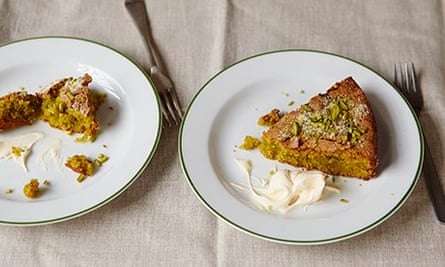
Moist, fragrant and very green, this cake is perfect with a dollop of loosely whipped cream and maybe a sprinkle of icing sugar.
Serves 8
200g shelled pistachios
8 cardamom pods
100g polenta
1 tsp bicarbonate of soda
50g butter
175ml extra virgin olive oil
3 medium eggs, at room temperature
200g caster sugar
1 unwaxed lemon
1 Preheat the oven to 170C/340F/gas mark 3-4. Grease and line a 23cm round baking tin. Place the pistachios on a dry baking tray and toast in the oven for 3 minutes until they have a greasy shine and a nutty aroma. Remove and set aside to cool.
2 Bash the cardamom pods using a pestle and mortar, discard the husks, and grind the seeds to a fine powder.
3 Tip the pistachios and cardamom powder into a food processor and pulse until they're finely ground. Pour the pistachios into a large bowl with the polenta and bicarbonate of soda and mix until evenly combined.
4 Place the butter and olive oil into a small pan on a low heat until the butter has melted but not boiled. Leave to cool slightly.
5 In a second large bowl, whisk the eggs and sugar together until light, fluffy and thick enough to slowly fall off the whisk in a ribbonon the surface of the mixture. Very slowly trickle in the butter and oil, slowly whisking it into the eggs until fully incorporated, then gently fold through the nut and polenta mixture. Zest the lemon, then halve and add the juice and zest to the mix. Stir to combine.
6 Pour into the greased tin and bake for 45-50 minutes. Check that a skewer comes out clean and the surface springs back a little when you press in the centre. The cake will have risen with a golden top, but don't be upset if the middle has collapsed slightly or even cracked.
7 Rest in the tin until cool, and serve in thick slices with a dollop of cream. This cake is so moist that it actually improves the flavour to keep for a day or two. However, its vibrant green colour will start to fade.
One: A Cook and her Cupboard by Florence Knight (Salt Yard)
Olive oil confit chicken
Olive oil is often used for confit in Provence, and is much more cost-effective than duck fat. The sweet but sharp salad cuts through the richness of the chicken.
Serves 2-4
2 tsp salt
4 sprigs lemon thyme, 2 sprigs leaves picked, 2 left whole
4 garlic cloves, 2 crushed, 2 skin on and bruised
4 juniper berries, crushed
8 black peppercorns, crushed
1 small orange, zest only
500g chicken drumsticks
1 litre mild olive oil
For the salad
2 tbsp rapeseed oil
½ garlic clove, finely grated
1 tbsp pomegranate molasses
1 orange, segmented, plus 1 tbsp juice
30g rocket
2 red endive, leaves separated
½ pomegranate, seeds only
1 To make the confit, crush the salt with the thyme leaves, crushed garlic, juniper, peppercorns and orange zest. Place the chicken legs in a Ziploc bag, sprinkle with the flavouredsalt mix and leave in the fridge overnight.
2 Preheat the oven to 150C/300F/gas mark 2. Brush the excess salt off the chicken then place in a casserole and cover with the olive oil. Add the whole sprigs of lemon thyme and the bruised garlic. Cover then cook for 2 hours, or until the meat falls off the bone.
3 Drain the chicken on a rack. Reserve 1 tbsp of the oil, and heat in a large frying pan. Fry the legs over a medium-high heat until they are brown and crispy (about 2 minutes each side).
4 To make the salad dressing, mix the rapeseed oil, garlic, pomegranate molasses, the orange juice, salt and pepper.
5 Place the rocket on a large plate, top with the endive leaves and the orange slices. Sprinkle with the pomegranate seeds and drizzle with the dressing, then serve with the chicken.
Recipe supplied by Olia Hercules, therecipekit.co.uk
